Structural Adhesives Market by Technology (Solvent-based, Water-based), Resin (Epoxy, Polyurethane, Acrylic, MMA, Cyanoacrylate), Application (Building & Construction, Automotive, Wind Energy, Aerospace), & Region - Global Forecast to 2029
The global structural adhesives market size was USD 13.5 billion in 2024 and is projected to reach USD 17.7 billion by 2029, at a CAGR of 5.5% between 2024 and 2029. The growing emphasis on sustainable and green manufacturing processes further drives the adoption of water-based structural adhesives across various industries.
Attractive Opportunities in the Structural Adhesives Market
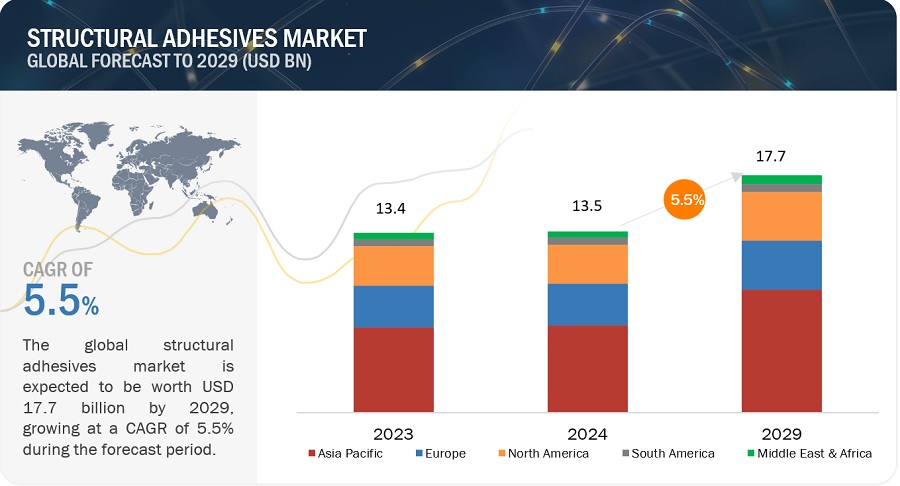
Source: Expert Interviews, Secondary Sources, and MarketsandMarkets Analysis
To know about the assumptions considered for the study, Request for Free Sample Report
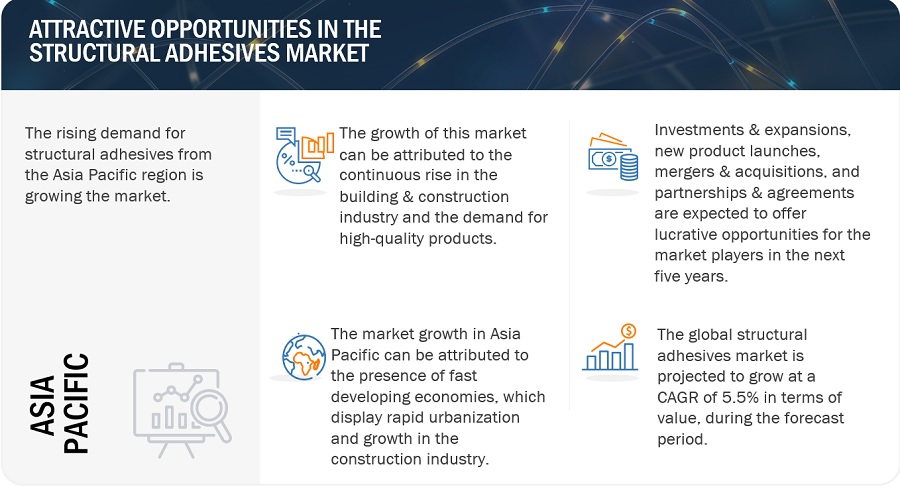
Source: Expert Interviews, Secondary Sources, and MarketsandMarkets Analysis
Structural Adhesives Market Dynamics
Drivers: Growing trend for lightweight and low carbon-emitting vehicles
The automotive industry is a significant end-user of structural adhesives, which are crucial for improving both the aesthetics and performance of vehicles. Reducing vehicle weight is essential for enhancing fuel efficiency and reducing pollutant emissions. Traditionally, adhesives were used for laminating, bonding, and assembling interior automotive components. Today, modern adhesives are pivotal in helping original equipment manufacturers (OEMs) achieve weight reduction and meet strict environmental regulations by minimizing carbon emissions. This shift has created new growth opportunities for adhesive manufacturers.
Restraints: Stringent environmental regulations in North American and European countries
Environmental laws strictly regulate the production of chemical and petro-based products in Europe and North America. Production of chemical and petro-based products in Europe and North America is strictly regulated by agencies like the Epoxy Resin Committee (ERC) and the European Commission (EC). These regulations impact the production capacities of manufacturers in these regions. As a result, stringent environmental rules are driving manufacturers to shift towards producing eco-friendly structural adhesives.
Opportunities: Increasing demand for non-hazardous, green, and sustainable structural adhesives
The demand for green adhesives, particularly those with low VOC levels, is rising as eco-friendly products gain popularity in various applications. Stringent regulations by the USEPA, Europe's REACH, LEED, and other regional authorities have compelled manufacturers to produce low-VOC, eco-friendly adhesives. These regulatory policies have spurred a growing trend in the global structural adhesives market towards green buildings, creating opportunities for the development of sustainable adhesive solutions. These solutions are made from renewable, recycled, remanufactured, or biodegradable materials that are safe for health and the environment.
Challenges: Regulatory compliance
The structural adhesives market undergoes frequent changes in standards and rules implemented by various regulatory authorities. The Construction Products Regulation (CPR) implemented new regulations such as regulation (EU) No 305/2011 for marketing construction products in the EU. With the new rules, manufacturers must bear additional burdens regarding labeling paperwork and external test costs to demonstrate compliance. Additional substance alerts focusing on biocides and waste packaging occur regularly, leading to changes in regulatory standards. Structural adhesive manufacturers must abide by the rules and changing standards to commercialize their products. This poses a challenge for the manufacturers.
Structural Adhesives Market Ecosystem.
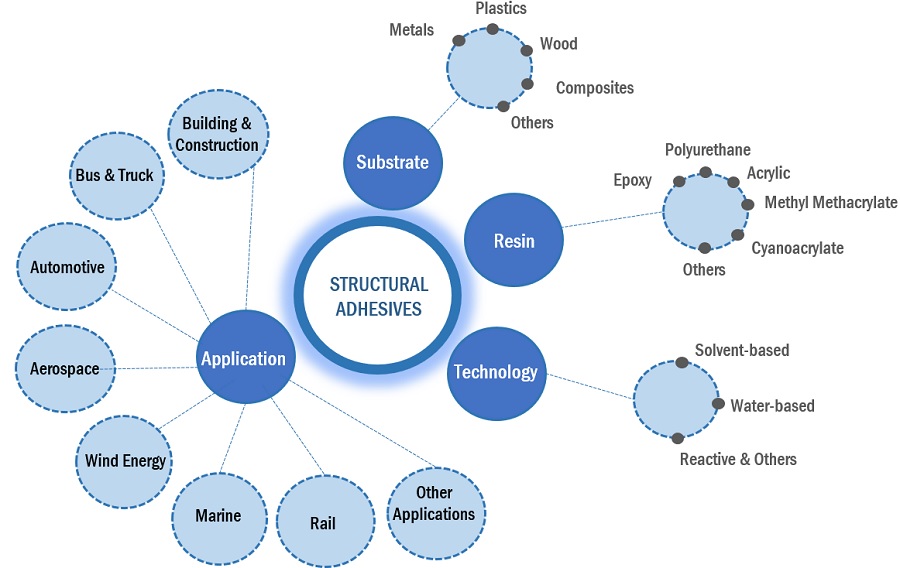
Water-based accounted for the largest technology segment of structural adhesives market.
Water-based technology dominates the technology segment of the structural adhesives market, primarily because of its eco-friendly characteristics and adherence to strict regulatory guidelines aimed at decreasing volatile organic compounds (VOCs). These adhesives offer notable safety advantages, including minimal odor and lower toxicity levels, making them the preferred choice for indoor and consumer applications. Moreover, continuous advancements in water-based formulations have substantially enhanced their performance, approaching the strength and durability levels of solvent-based alternatives. The increasing focus on sustainable and environmentally friendly manufacturing processes further accelerates the adoption of water-based structural adhesives across diverse industries.
Asia Pacific is the largest growing structural adhesives market.
Leading global companies are shifting their production bases, establishing sales offices, and enhancing distribution channels to regions such as Asia Pacific, offering sustained demand. The gradual shift of manufacturing facilities to countries with high demand and lower production costs positively influences market growth. The key producers control a significant share of the global market. As a result, there is strong competitive pressure on structural adhesives producers to reduce the prices to gain market share at the expense of competitors.
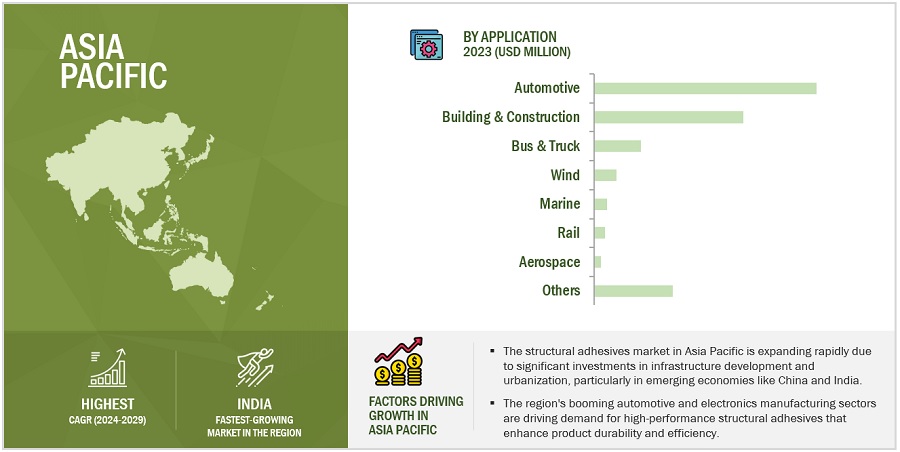
To know about the assumptions considered for the study, download the pdf brochure
Key Market Players
Henkel AG & Co. KGaA (Germany), Sika AG (Switzerland), 3M (US), DuPont (US), and Huntsman Corporation (US) are the key players in the global structural adhesives market.
Henkel operates globally with a well-balanced and diversified portfolio. It manufactures and distributes homecare, laundry, cosmetics, and adhesive products globally. The company operates through three business segments: adhesive technologies, consumer brands, and corporate. Structural adhesives are produced under the adhesive technologies segment. Henkel offers a multitude of applications to cater to the needs of different target groups: consumers, craftsmen, and industrial businesses. Henkel Adhesive Technologies is the global leader in adhesives, sealants, and functional coatings worldwide. The structural adhesives are manufactured under the LOCTITE, TECHNOMELT, and TEROSON.
Get online access to the report on the World's First Market Intelligence Cloud
- Easy to Download Historical Data & Forecast Numbers
- Company Analysis Dashboard for high growth potential opportunities
- Research Analyst Access for customization & queries
- Competitor Analysis with Interactive dashboard
- Latest News, Updates & Trend analysis
Request Sample Scope of the Report
Get online access to the report on the World's First Market Intelligence Cloud
- Easy to Download Historical Data & Forecast Numbers
- Company Analysis Dashboard for high growth potential opportunities
- Research Analyst Access for customization & queries
- Competitor Analysis with Interactive dashboard
- Latest News, Updates & Trend analysis
|
Report Metric |
Details |
|
Years Considered for the study |
2021-2029 |
|
Base year |
2023 |
|
Forecast period |
2024–2029 |
|
Units considered |
Value (USD) |
|
Segments |
By Substrate |
|
Regions covered |
Asia Pacific, Europe, North America, South America, and Middle East & Africa |
|
Companies profiled |
Henkel AG & Co. KGaA (Germany), Sika AG (Switzerland), 3M (US), DuPont (US), and Huntsman Corporation (US). A total of 25 players have been covered. |
This research report categorizes the structural adhesives market based on substrate, resin, technology, application, and region.
By Substrate:
- Metals
- Plastics
- Wood
- Composites
- Others
By Resin:
- Epoxy
- Polyurethane (PU)
- Acrylic
- Methyl Methacrylate (MMA)
- Cyanoacrylate
- Others
By Technology:
- Solvent-based
- Water-based
- Reactive & Others
By Application:
- Building & Construction
- Automotive
- Bus & Truck
- Wind
- Marine
- Rail
- Aerospace
- Others
By Region:
- Asia Pacific
- Europe
- North America
- South America
- Middle East & Affrica
Recent Developments
- In December 2022, Henkel expanded its operations in Salisbury, North Carolina. This expansion of Henkel’s existing site brings a new 10,000 square foot, state-of-the-art production area. The new production area at the Salisbury facility is a major investment for Henkel and represents the first large-scale UV hot melt production plant outside Europe, creating a significant resource for customers in North America.
- In May 2021, Henkel AG announced the construction of a new Adhesive Technologies Innovation Center in Shanghai. With an investment of more than Euro 60 million (USD 71 million), this facility will transform Henkel’s current Zhangjiang site into an Innovation Center for China and the Asia Pacific. The new site will strengthen Henkel Adhesive Technologies's position to serve various industries and develop leading adhesives, sealants, and functional coatings solutions for customers in the region.
Frequently Asked Questions (FAQ):
What are the growth driving factors of structural adhesives?
The growth of the structural adhesives market is primarily driven by the increasing use of modified epoxies and polyurethane adhesives, along with increasing penetration of methyl methacrylate adhesives, in the wind energy, marine, building & construction, and automotive applications.
What are the major applications for structural adhesives?
The major applications of structural adhesives are building & construction, automotive, bus & truck, wind, marine, rail, aerospace, and others.
Who are the major manufacturers?
Henkel AG & Co. KGaA (Germany), Sika AG (Switzerland), 3M (US), DuPont (US), and Huntsman Corporation (US) are some of the leading players operating in the global structural adhesives market.
What are the reasons behind structural adhesives gaining market share?
Structural adhesives coating are gaining market share due to growing automotive industry.
Which is the largest region in the structural adhesives market?
Asia Pacific is the largest region in structural adhesives market. .
To speak to our analyst for a discussion on the above findings, click Speak to Analyst
This research study involves the use of extensive secondary sources, directories, and databases, such as Hoovers, Bloomberg L.P., Factiva, ICIS, and OneSource, to identify and collect information useful for this technical, market-oriented, and commercial study of the global structural adhesives market. Primary sources are mainly industry experts from core and related industries, preferred suppliers, manufacturers, distributors, service providers, and organizations related to all segments of the value chain of this industry. In-depth interviews were conducted with various primary respondents, including key industry participants, subject matter experts (SMEs), C-level executives of key market players, and industry consultants, among other experts, to obtain and verify critical qualitative and quantitative information as well as assess growth prospects of the market.
Secondary Research
Various secondary sources have been referred to in the secondary research process to identify and collect information for this study. These secondary sources include annual reports, press releases, investor presentations of companies, white papers, regulatory bodies, trade directories, certified publications, articles from recognized authors, gold & silver standard websites, and databases.
Secondary research has been used to obtain key information about the industry's value chain, the total pool of key players, market classification & segmentation according to industry trends to the bottom-most level and regional markets. It has also been used to obtain information about key developments from a market-oriented perspective.
Primary Research
In the primary research process, various sources from both the supply and demand sides have been interviewed to obtain qualitative and quantitative information for this report. Primary sources from the supply side include CEOs, vice presidents, marketing and sales directors, business development managers, technology and innovation directors of adhesives manufacturing companies, and suppliers and distributors. Primary sources from the demand side include industry experts—directors of end-use industries and related key opinion leaders.
Following is the breakdown of primary respondents:
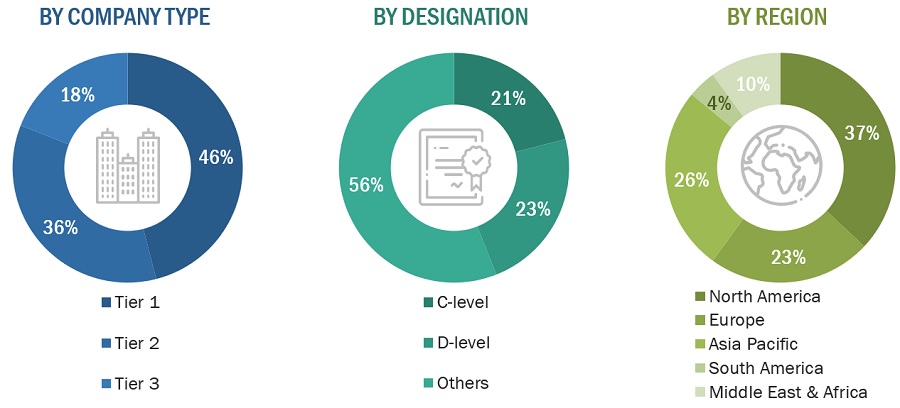
To know about the assumptions considered for the study, download the pdf brochure
Market Size Estimation
Both the top-down and bottom-up approaches have been used to estimate and validate the size of the structural adhesives market in various applications in each region. The research methodology used to estimate the market size includes the following steps:
- The key players in the market have been identified in the respective regions through primary and secondary research.
- All percentage shares, splits, and breakdowns have been determined by using secondary sources and verified through primary sources.
All possible parameters that affect the market and submarkets covered in this research study have been accounted for, viewed in extensive detail, verified through primary research, and analyzed to get the final quantitative and qualitative data. The data has been consolidated and supplemented with detailed inputs and analysis from the MNM data repository and presented in this report.
Global Structural Adhesives Market Size: Bottom-Up Approach
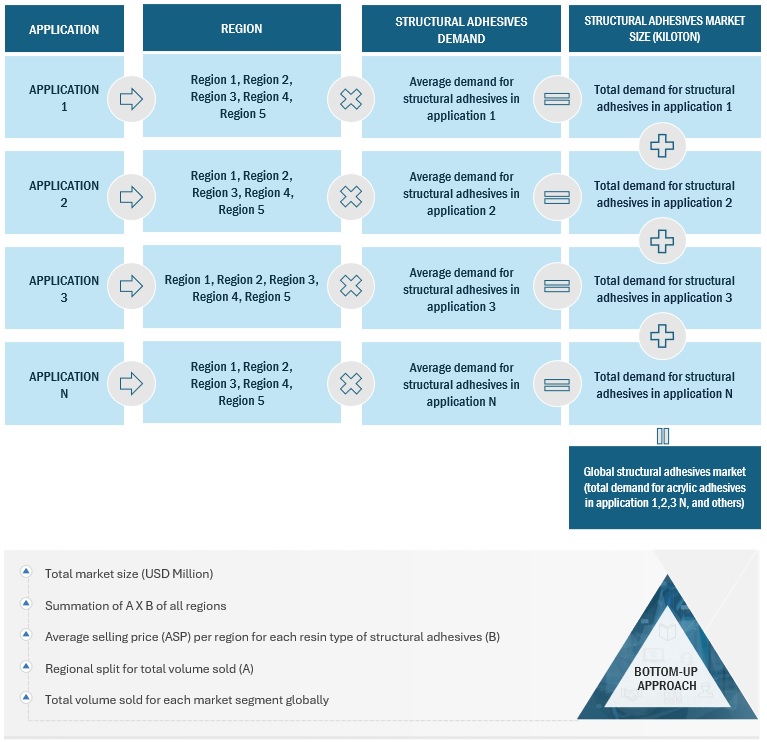
To know about the assumptions considered for the study, Request for Free Sample Report
Data Triangulation
After arriving at the overall market size from the estimation process explained above, the total market has been split into several segments and sub-segments. Data triangulation and market breakdown procedures have been used wherever applicable to complete the overall market engineering process and arrive at the exact statistics for all the segments and sub-segments. The data has been triangulated by studying various factors and trends from both the demand & supply sides. In addition, the market has been validated using both the top-down and bottom-up approaches. It has then been verified through primary interviews. Hence, for each data segment, there are three sources — the top-down approach, the bottom-up approach, and expert interviews. Only when the values from the three sources matched the data have been assumed to be correct.
Market Definition.
According to FEICA, the Association of the European Adhesive and Sealant Industry, structural adhesives are adhesives which are used to bond load-bearing joints or substrates. They are capable of handling high tensile, shear, cleavage, and peel strength between the substrates and provide excellent mechanical performance. They enable weight reduction and improve the aesthetic appeal of end products without any visible bolts, rivets, and welds. These adhesives offer excellent strength, load-bearing capability, durability, and resistance against impact, heat, fatigue, and solvents. All structural adhesives provide at least 1,000 psi or 7 Mpa of overlap shear strength to the substrates. Structural adhesives come in many forms, including low viscosity liquids and non-sag pastes, one- and two-component formulations, and short and long work lives, among others.
Key Stakeholders
- Senior Management
- End User
- Finance/Procurement Department
- R&D Department
Report Objectives
- To define, describe, and forecast the structural adhesives market in terms of value and volume
- To provide detailed information about the key factors (drivers, restraints, opportunities, and challenges) influencing market growth
- To analyze and forecast the market by substrate, resins, technology, application, and region
- To project the structural adhesives market size for North America, Europe, Asia Pacific, the Middle East & Africa, and South America
- To strategically analyze micromarkets1 concerning individual growth trends, growth prospects, and their contribution to the overall market
- To analyze the opportunities in the market for stakeholders and provide a competitive landscape for the market leaders
- To analyze competitive developments, such as product launches, acquisitions, investments, expansion, and agreements in the market
- To strategically profile the key players and comprehensively analyze their market shares and core competencies2
1. Micromarkets are defined as the sub-segments of the structural adhesives market included in the report.
2. Core competencies of companies are determined in terms of the key developments and important strategies adopted by them to sustain in the market.
Available Customizations
MarketsandMarkets offers customizations according to the specific needs of the companies with the given market data.
The following customization options are available for the report:
Product Analysis
- Product matrix, which gives a detailed comparison of the product portfolio of each company
Regional Analysis
- Further breakdown of the structural adhesives market, by country
Company Information
- Detailed analysis and profiling of additional market players (up to five)












Growth opportunities and latent adjacency in Structural Adhesives Market
Report view of section 4.2 for Structural Adhesive market report
Market prosprection on structural adhesive market with specific interest on epoxy adhesives.
Interest in a specific section of the report
Production and consumption data on each type of adhesives for the Saudi Arabia and the Gulf region